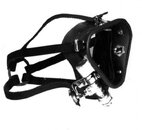...I would love some more details of your insane submerged Saturation on the Andrea Doria. I remember reading about it as a 19 year old in Aberdeen, not knowing that 24 years later I would bump into you on the internet....
There are way too many insane details to fit in a post! The most accurate documentation on that dive was written by Jack McKinney in Skin Diver Magazine. It was a 2-part article that ran in January and February 1974.
This was the shallowest sat I ever made at ~150' (depth was tidal), floating above her Port side at 160'. Seabed is about 240'. Most of the dive was spent cutting away the double hull doors to the first class foyer, which Oceaneering divers later enlarged about 3x on the Gimbal dive years later (Gimbal's hole).
Basically, we couldn't afford to build a conventional surface-based sat system let alone the vessel to support it. Our "support ship" was the same 85' fishing boat that Bruno Valatti(sp?) chartered in the late 1960s to film her (all air Scuba). I got the information on the Narragansett (fishing boat) and deck plans for the Doria from Al Giddings who was on that project... not engineering drawings from the ship yard, an enlarged copy of the deck layout that they gave to passengers!
We raised money from investors to build a single lock "habitat" that was 5' in diameter x 12½' long and rated for 300'. It had a small medical lock that could be used when completing decompression after the Habitat was lifted onto the pier. The money went entirely to materials and operating costs while labor was a gamble for a percentage of the recovery... which amounted to well under zero -- it cost more than we had and took a couple of years to pay off.
We also had a 54" double-lock chamber onboard for Sur-D-O
2 (Surface Decompression using Oxygen) and treating hits to surface divers. Several of us made 4 surface jumps/day in Scuba to set up the habitat, alternating air and HeO
2 with water stops at 20' on pure O
2 before completing decompression in the double-lock. A Navy hyperbaric doc onboard came up with the concept and it worked great. We did run some Table 5s (DCS treatments) on some of support divers and photographers that were on air only. The fish hold was crammed with gas bottles, spares, tools, and bunks.
Without a doubt our biggest problem was swinging on a single-point moor, followed closely by being in the separation zone for shipping lanes to New York. The "plan" was to disconnect and toss umbilicals over the side with buoys and trip a Pelican Hook on the mooring ball to evade any oncoming ships that weren't looking at the radar or listening to the USCG bullions on the radio. Good thing we didn't have to resort to that because the umbilical probably would have wrapped around some freighter's screw, yanking the habitat off the Port side with one or both of use dangling by our umbilicals. "Occupational Hazards" are a lot more acceptable in your 20s on what amounted to a treasure salvage... sure glad Darwin was on vacation that month!
Fortunately, nobody was hurt -- aside from egos and bank accounts. Everyone worked incredibly hard, but I doubt any of us would trade that "learning experience" for a holiday in the Caribbean.
Preventing the mooring cable from tying bowlines in the habitat and welding/burning umbilicals was a constant battle. I can't remember how many times the burning umbilical had to be man-handled back to the surface for repairs. Food and SodaSorb was replenished by support Scuba divers every day or two using a modified paint pot. Fortunately, Mother (the habitat) was only about 40' from the down-line.
After finally getting the doors off we dropped into the foyer to discover flooring, bulkheads, and overheads floating around suspended by electrical wiring. Naturally all the safes were either amidships or on the starboard side in the mud. We didn't need an accountant to tell us clearing all that stuff so we could work under it would cost a lot more than was in all the safes combined, let alone what we would lose in Admiralty Court.
...BTW - I think that is by far the deepest habitat saturation ever achieved.
Deepest, not even close. Least expensive maybe. Ed Link's SPID was at 131 meters (432') in 1964. Cousteau's Conshelf III was at 102.4 meters (336') in the Med in 1965. SeaLab I was in 58 m (192') in 1964 and SeaLab II was in 58 m (204') in 65. SeaLab III was at 186 m (610') but was scrubbed when Barry Cannon died before anyone got in the habitat. They were already saturated in the surface-based Mark II Deep Dive System aboard the Elk River (IX-501), where I was stationed several years later. Our Doria dive was in 1973. Exciting times.





